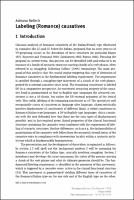Chapter Labeling (Romance) causatives
Author(s)
Belletti, Adriana
Contributor(s)
Aboh, Enoch (editor)
Haeberli, Eric (editor)
Puskás, Genoveva (editor)
Schönenberger, Manuela (editor)
Collection
European Research Council (ERC); EU collectionLanguage
EnglishAbstract
Classical analyses of Romance causatives of the Italian/French type illustrated in examples like (2) and (3) below for Italian, proposed that an overt process of VP-preposing occurs in the derivation of these structures (in particular Kayne 1975; Rouveret and Vergnaud 1980; Zubizarreta 1985; Burzio 1986). Phrasing the proposal in current terms, this process can be identified with and reduced to an instance of a family of syntactic processes moving chunks of a verb phrase, often referred to as smuggling, following Collins’ (2005) terminology. The main proposal of this article is that the crucial engine triggering this type of derivation of Romance causatives is the fundamental labeling requirement. The requirement is satisfied through a smuggling-type movement of a chunk of the verb phrase, probed by a criterial causative voice head. The remaining constituent is labeled DP. In a comparative perspective, the movement attracting property of the causative head is parametrized so that in English-type languages the attracted constituent is not a vP-chunk, but rather the DP-external argument of the lexical verb. This yields labeling of the remaining constituent as vP. The special yet well recognizable status of causatives in language after language, characteristically involves displacement of constituents of different kinds, a verbal constituent in Romance/Italian-type languages, a DP in English-type languages; this is consistent with the idea defended here that these are the only types of displacements possible, and in fact required given shared properties of the clausal functional structure containing the causative voice combined with the requirement of labeling of syntactic structures. Further differences such as e.g. the (im)possibility of passivization of the causative verb follow from the assumed criterial status of the causative voice in compliance with intervention locality within a syntactic architecture which is fundamentally homogeneous. The presentation and the development of these ideas is organized as follows: In section 2 I will spell out the background analysis I will be assuming for Romance causatives of the Italian type, crucially involving smuggling. Section 3 introduces and develops the issue concerning the status of the process moving a chunk of the verb phrase and what its ultimate generator should be. The fundamental labeling requirement is identified as the generator of this movement, which is triggered by a causative voice, active in the clausal functional structure (3.1). This movement is parametrized yielding different types of causatives of the Romance/Italian type on the one side and of the English type on the other. The criterial status of the causative head is then assumed (3.1.2) as the fundamental source of differences in the possibility of passivization in the two types of causatives. Some comparative considerations on French conclude the analysis (3.1.2.1). Section 4 addresses the comparison between the smuggling process of causatives with the one currently assumed for passive (4.1). Some relevant considerations inspired by recent results in acquisition are finally discussed (4.2). Section 5 concludes the article.
Keywords
Generative Syntax; Comparative Syntax; Micro-comparative SyntaxDOI
10.1515/9781501504037-002ISBN
9781501518935; 9781501503979OCN
1135854301Publisher
De GruyterPublisher website
https://www.degruyter.com/Publication date and place
Berlin/Boston, 2017Grantor
Classification
Linguistics
Grammar, syntax and morphology


 Download
Download